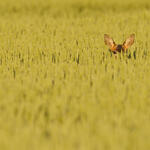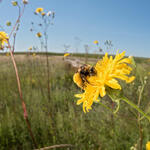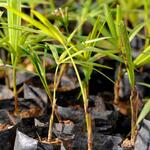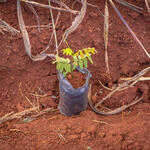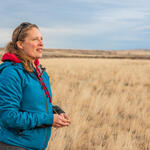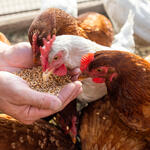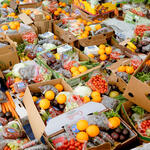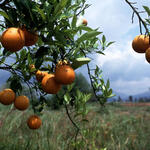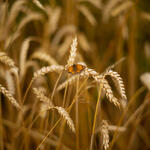- Date: 22 May 2023
For our Rising Stars series, we're featuring the next generation of leaders who are working toward a more sustainable world. We recently spoke with Niamh Lehane, Manager, CSR and Sustainability with CVS Health, to learn about her role, connection to nature, and advice for those new to the field.
- Date: 16 May 2023
- Author: Alix Grabowski, Director, Plastic and Material Science, WWF
Plastic made from plants (also known as bioplastic or bio-based plastic) holds the potential to be more sustainable and better for the planet. But not all plant-based plastic is created equal. The type of feedstock (biological material used to make the plastic) matters, as does where and how it is produced and harvested. If these factors are not carefully considered, there may be unintended negative consequences for nature and people.
To ensure plant-based plastic is designed to build environmental, social, and economic resilience across ecosystems and communities, WWF convened the Bioplastic Feedstock Alliance (BFA). BFA brings a science-based perspective to the sourcing of plant-based plastics and their role in circular systems, ensuring that any shift to plant-based inputs brings lasting value to nature and people.
- Date: 15 May 2023
- Author: Suzy Friedman, Senior Director of Food Policy, WWF
Many of us understand the value of protecting forests but have yet to learn that protecting and restoring grasslands is of equal importance. Grasslands—so important for people, nature and climate—are being plowed up at an astounding rate both here in the U.S. and around the world. This is especially damaging as grasslands help us tackle the dual crises of biodiversity loss and climate change.
Grasslands are critical for biodiversity and nature. They hold approximately one-third of global terrestrial carbon stocks and provide climate resilience in the face of increasing droughts, heatwaves and wildfires. They are also essential to the livelihoods and food security of communities around the world and provide valuable resources like food, energy and wildlife habitat.
- Date: 11 May 2023
This time of year we celebrate mothers and all caregivers who take on the critical role of protector and nurturer. Mother figures are strong; they are resilient; and they create the conditions that allow others to grow and thrive. But this doesn’t just apply to people—mothers are just as important to forests. Every forest has “mother trees”: certain species of fully-grown, reproductive trees that allow forests to establish themselves, adapt to adversities and develop for the long-term.
- Date: 11 May 2023
- Author: Edward Wyatt
In Central Brazil’s vast Cerrado savanna, a grand experiment is taking place. Baru trees by the hundreds are being planted – some in the form of seeds, some as seedlings, and some well on their way to maturity in agroforests alongside other native vegetation. In some tracts, cattle graze among the more mature baru trees, in other areas, no cows are allowed.
The point of all this testing is to uncover the premium growing conditions under which the baru (Dipteryx alata) can thrive. The species, native to the Brazilian Cerrado, is a key part of reforestation efforts in the state of Mato Grosso do Sul. And overseeing a reforestation project on the Boa Vida farm near town of Bonito is a woman who is a “traditional seed guardian,” Elida Cristina Martins.
“I found that if we planted baru with bananas nearby it grows much faster than when planted alone, and the bananas help break the wind and keep the ground wet to keep the baru healthy,” she said as she gave a recent tour of her farm to a group of visitors from World Wildlife Fund (WWF) and the Tapestry Foundation.
- Date: 05 May 2023
After decades of farming small grains on his family farm and ranch near Buffalo, South Dakota, David Niemi decided the landscape needed a change. David’s father planted nearly 2,000 acres of their ranch into small grain production in the 1960’s to diversify their operation, and the family continued to plant annual crops on the field until recent extreme drought conditions made farming it no longer a viable option. David decided that the best thing he could do for the land and his family business would be to re-seed- drought tolerant, hardy native plant species.
While exciting, reseeding projects which aim to return previously tilled farm ground to resilient grassland can be very expensive for producers. Often producers who decide they’d like return farm ground to its previous resiliency are met with a cost prohibitive estimate for seed. The cost of replanting ground back to (or close to) its original species mix is typically costly enough that producers aren’t able to make the project work out on the balance sheet. Fortunately, partnerships, like the one between Air Wick and World Wildlife Fund’s Northern Great Plains Program, are being developed to support reseeding projects on the Niemi’s ranch and many others.
- Date: 01 May 2023
- Author: Sam Wildman, Sr. Program Officer – Sustainable Protein Systems, WWF
Over the past year, I’ve been lucky to collaborate with many American Feed Industry Association and Institute for Feed Education and Research staff and members, forging the first-ever partnership between our organizations. The goal was to elevate a vision that feed and animal nutrition can be a critical lever in providing sustainable solutions to food systems.
World Wildlife Fund’s mission is to build a future in which people live in harmony with nature. That includes making sure there is enough food for a growing population, while protecting our planet’s critical natural resources like water, forests, and clean air. The feed industry, with its global influence, has unique potential to help build that sustainable future.
- Date: 26 April 2023
- Author: Alex Nichols-Vinueza, Program Manager, Food Loss and Waste; Leigh Prezkop, Senior Program Officer, Food Loss and Waste
Organizations are increasingly working to reduce food loss and waste (FLW) across the food supply chain in support of their commitments to address food insecurity and climate change. That work often starts with donating or composting excess food to keep it out of landfills (where food waste emits methane). While this downstream work is incredibly important, the overwhelming majority of the food system’s environmental impacts occur upstream at the farm level, and the larger challenge is how buyers and growers can more closely coordinate to reduce FLW in a way that utilizes more of what we already grow and shrinks the footprint of agriculture.
In nature, nothing is wasted, and by mimicking this approach, we can develop more circular pathways that use surplus food along the supply chain to first feed those in need, and then develop new sales channels for growers to justify harvesting more of their crop, feed animals, and fertilize their crops—all helping to reduce our natural resource use and impact on biodiversity in the process.
- Date: 26 April 2023
At least 35% of all food in the US is left behind in fields or goes to waste, while millions of Americans face food insecurity. Businesses, government agencies, funders, and many others are already taking huge strides to address this challenge. But a patchwork of initiatives, no matter how impressive or innovative, will never be enough to make the rapid and dramatic reductions in food waste required to sustain ourselves and our planet. We cannot solve this problem without ambitious leadership and action on the federal level and across all 50 states. This is where the Zero Food Waste Coalition comes in.
- Date: 25 April 2023
- Author: Alex Nichols-Vinueza, Program Manager, Food Loss and Waste; Leigh Prezkop, Senior Program Officer, Food Loss and Waste
Thus far, the regenerative agriculture movement and its impacts on land rehabilitation have held little consensus. Many broadly reduce this farming approach to practices like no-till, crop rotations, and cover cropping with the simple purpose of reducing chemical and fertilizer inputs. Others underscore the movement's role in reorienting our production philosophies to emphasize reciprocal relationships with the environment and our food systems. For World Wildlife Fund, regenerative agriculture is centered on being deforestation and conversion free, rebuilding soil health, protecting water ecosystems, and supporting biodiversity, food producers, and agricultural communities.
As it stands, roughly 15% of all food produced is wasted at the farm stage, according to WWF’s recent Driven to Waste report. For farmers, this has meant the immediate loss of profits and reduced productivity in farmland over time. However, regenerative agriculture has the potential to revitalize ecosystem services and help reduce on-farm food loss and waste. To date, there has been limited research into how the farming methods associated with regenerative agriculture can reduce these adverse effects – and WWF aims to fill this gap.

